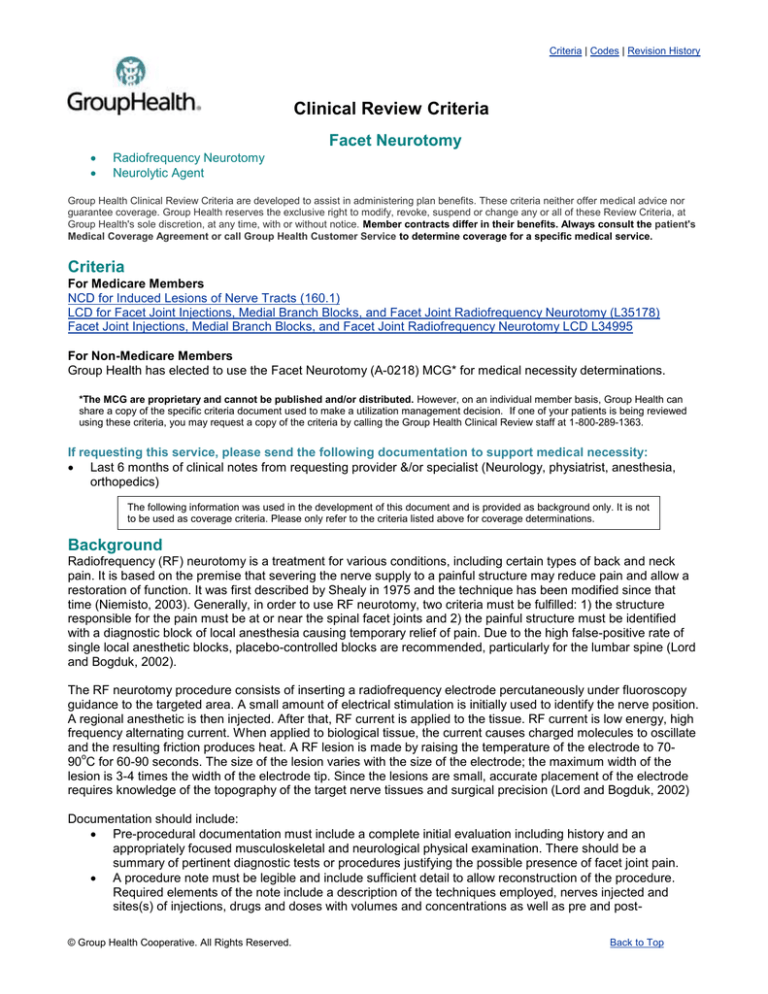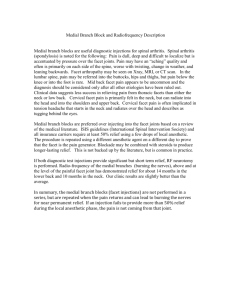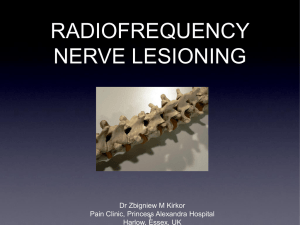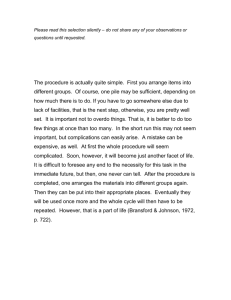
Criteria | Codes | Revision History
Clinical Review Criteria
Facet Neurotomy
Radiofrequency Neurotomy
Neurolytic Agent
Group Health Clinical Review Criteria are developed to assist in administering plan benefits. These criteria neither offer medical advice nor
guarantee coverage. Group Health reserves the exclusive right to modify, revoke, suspend or change any or all of these Review Criteria, at
Group Health's sole discretion, at any time, with or without notice. Member contracts differ in their benefits. Always consult the patient's
Medical Coverage Agreement or call Group Health Customer Service to determine coverage for a specific medical service.
Criteria
For Medicare Members
NCD for Induced Lesions of Nerve Tracts (160.1)
LCD for Facet Joint Injections, Medial Branch Blocks, and Facet Joint Radiofrequency Neurotomy (L35178)
Facet Joint Injections, Medial Branch Blocks, and Facet Joint Radiofrequency Neurotomy LCD L34995
For Non-Medicare Members
Group Health has elected to use the Facet Neurotomy (A-0218) MCG* for medical necessity determinations.
*The MCG are proprietary and cannot be published and/or distributed. However, on an individual member basis, Group Health can
share a copy of the specific criteria document used to make a utilization management decision. If one of your patients is being reviewed
using these criteria, you may request a copy of the criteria by calling the Group Health Clinical Review staff at 1-800-289-1363.
If requesting this service, please send the following documentation to support medical necessity:
Last 6 months of clinical notes from requesting provider &/or specialist (Neurology, physiatrist, anesthesia,
orthopedics)
The following information was used in the development of this document and is provided as background only. It is not
to be used as coverage criteria. Please only refer to the criteria listed above for coverage determinations.
Background
Radiofrequency (RF) neurotomy is a treatment for various conditions, including certain types of back and neck
pain. It is based on the premise that severing the nerve supply to a painful structure may reduce pain and allow a
restoration of function. It was first described by Shealy in 1975 and the technique has been modified since that
time (Niemisto, 2003). Generally, in order to use RF neurotomy, two criteria must be fulfilled: 1) the structure
responsible for the pain must be at or near the spinal facet joints and 2) the painful structure must be identified
with a diagnostic block of local anesthesia causing temporary relief of pain. Due to the high false-positive rate of
single local anesthetic blocks, placebo-controlled blocks are recommended, particularly for the lumbar spine (Lord
and Bogduk, 2002).
The RF neurotomy procedure consists of inserting a radiofrequency electrode percutaneously under fluoroscopy
guidance to the targeted area. A small amount of electrical stimulation is initially used to identify the nerve position.
A regional anesthetic is then injected. After that, RF current is applied to the tissue. RF current is low energy, high
frequency alternating current. When applied to biological tissue, the current causes charged molecules to oscillate
and the resulting friction produces heat. A RF lesion is made by raising the temperature of the electrode to 70o
90 C for 60-90 seconds. The size of the lesion varies with the size of the electrode; the maximum width of the
lesion is 3-4 times the width of the electrode tip. Since the lesions are small, accurate placement of the electrode
requires knowledge of the topography of the target nerve tissues and surgical precision (Lord and Bogduk, 2002)
Documentation should include:
Pre-procedural documentation must include a complete initial evaluation including history and an
appropriately focused musculoskeletal and neurological physical examination. There should be a
summary of pertinent diagnostic tests or procedures justifying the possible presence of facet joint pain.
A procedure note must be legible and include sufficient detail to allow reconstruction of the procedure.
Required elements of the note include a description of the techniques employed, nerves injected and
sites(s) of injections, drugs and doses with volumes and concentrations as well as pre and post© Group Health Cooperative. All Rights Reserved.
Back to Top
Criteria | Codes | Revision History
procedural pain assessments. With RF neurotomy, electrode position, cannula size, lesion parameters,
and electrical stimulation parameters and findings must be specified and documented.
Facet joint interventions (diagnostic and/or therapeutic) must be performed under fluoroscopic or
computed tomographic (CT) guidance. Facet joint interventions performed under ultrasound guidance will
not be reimbursed.
A hard (plain radiograph with conventional film or specialized paper) or digital copy image or images which
adequately document the needle position and contrast medium flow (excluding RF ablations and those
cases in which using contrast is contra-indicated, such as patients with documented contrast allergies),
must be retained and submitted if requested.
In order to maintain target specificity, total IA injection volume must not exceed 1.0 mL per cervical joint or
2 mL per lumbar joint, including contrast. Larger volumes may be used only when performing a purposeful
facet cyst rupture in the lumbar spine.
Total MBB anesthetic volume shall be limited to a maximum of 0.5 mL per MB nerve for diagnostic
purposes and 2ml for therapeutic. For a third occipital nerve block, up to 1.0 mL is allowed for diagnostic
and 2ml for therapeutic purposes.
In total, no more than 100 mg of triamcinolone or methylprednisolone or 15 mg of betamethasone or
dexamethasone or equivalents shall be injected during any single injection session.
Both diagnostic and therapeutic facet joint injections may be acceptably performed without steroids.
Medical Technology Assessment Committee (MTAC)
Back/Neck Pain
07/14/2004: MTAC REVIEW
Evidence Conclusion: Back Pain There is insufficient evidence to conclude that RF neurotomy improves health
outcomes among patients with back pain. Two of the three RCTs on back pain that were reviewed (LeClaire;
Barendse) did not find a significant benefit of RF neurotomy compared to a sham intervention in the primary
analysis. Barendse may have been underpowered to detect a clinically significant difference between groups. The
third study (van Kleef, 1999), which included patients with low back pain originating from the lumber zygapophysial
joint, found significantly more clinical successes in the RF neurotomy group. The latter study (n=32), which
included a multivariate analysis to adjust for baseline differences, had imprecise estimates with large confidence
intervals and only an 8-week follow-up period. All of the studies were limited by small sample sizes. In addition, all
of the studies used non-blinded diagnostic blocks and there may have been false positive findings of the location
of pain. Long-term safety and efficacy of RF neurotomy for treating back pain was not evaluated.
Evidence Conclusion: Neck pain There is insufficient evidence to conclude that RF neurotomy improves health
outcomes among patients with neck pain. One of the two RCTs reviewed (Lord) was well designed but had a
biased presentation of study results. The authors did not report their primary outcomes, pain and impact of pain on
activities of daily living, at the end of the double blind follow-up period at 3 months. The results they did report were
confounded by rescue treatment. The other RCT (van Kleef, 1996) found a significant benefit of RF neurotomy
compared to sham intervention for patients with cervicobrachial pain. The study is limited by its short (8-week)
follow-up period and small sample size (n=20), which can result in baseline differences between groups. Also, the
van Kleef, 1996 study used non-blinded diagnostic blocks and some patients may have been falsely identified with
cervicobrachial pain. Long-term safety and efficacy of RF neurotomy for treating neck pain was not evaluated.
Articles: The search yielded 23 articles. There was a Cochrane library review from 2003 that reviewed the
randomized controlled trials on the topic, but did not conduct a quantitative meta-analysis to evaluate the overall
effectiveness of the treatment. Seven double-blind sham-controlled RCTs met the inclusion criteria for the
Cochrane review. One additional small RCT published after the Cochrane review was identified in the Medline
search, but this study was excluded because the patient population had already failed intradiscal electrothermal
annuloplasty (IDET). The Cochrane investigators assigned a methodological quality score to each RCT they
included. Studies that received a quality score of at least 7 out of 10 were selected for this review. The Leclaire
and Barendse articles were by the same research groups, but included different study populations. Back pain:
There were four RCTs on the treatment of back pain. One RCT that had a low methodology score in the Cochrane
review was not reviewed. The remaining three RCTs were critically appraised: Leclaire R, Fortin L, Lambert R et
al. Radiofrequency facet joint denervation in the treatment of low back pain. Spine 2001; 26: 1411-1418. See
Evidence Table van Kleef M, Barendse GAM, Kessels A et al. Randomized trial of radiofrequency lumbar facet
denervation for chronic low back pain. Spine 1999; 24: 1937-1942. See Evidence Table Barendse GAM, van den
Berg SGM, Kessels AHF et al. Randomized controlled trial of percutaneous intradiscal radiofrequency
thermocoagulation for chronic discogenic back pain. Spine 2001; 26: 287-292. See Evidence Table Lord SM,
Barnsley L, Wallis BJ et al. Percutaneous radio-frequency neurotomy for chronic cervical zygapophyseal-joint pain.
N Engl J Med 1996; 335: 1721-1726. See Evidence Table
© Group Health Cooperative. All Rights Reserved.
Back to Top
Criteria | Codes | Revision History
The use of radiofrequency neurotomy in the treatment of chronic neck and back pain does not meet the Group
Health Medical Technology Assessment Criteria.
07/29/2005: MTAC REVIEW
Back Pain/Neck Pain
Evidence Conclusion: A PubMed search (2004 to present) yielded 6 articles. Four were review articles and one
was a study of electrode placement, not effectiveness. There was one new RCT (Stovner et al. Cephalalgia 2004;
24: 821). The study was not worth critically appraising because it only included 12 patients. It did not find a
significant benefit of radiofrequency neurotomy vs. sham treatment for next pain, but they almost certainly did not
have sufficient statistical power.
This review was not taken to the Medical Technology Assessment Committee. The information was not sufficient
to warrant a review by the committee.
Date
Created
07/14/2004
Date Reviewed
Revision
History
09/08/2015
Description
MDCRPC
MDCRPC
MDCRPC
MDCRPC
01/05/2010
, 05/04/2010
, 03/01/2011
, 01/03/2012
,
MDCRPC
MPC
MPC
MPC
MPC
11/06/2012
,09/03/2013 , 07/01/2014 , 05/05/2015 , 03/01/2016
MDCRPC
Medical Director Clinical Review and Policy Committee
MPC
Medical Policy Committee
Date Last
Revised
07/01/2014
Revised LCD for Facet Joint Injections, Medial Branch Blocks, and Facet Joint Radiofrequency
Neurotomy to L35178 and L34995
Codes
CPT: 64633, 64634, 64635, 64636, 0213T, 0214T, 0215T, 0216T, 0217T, 0218T
© Group Health Cooperative. All Rights Reserved.
Back to Top





